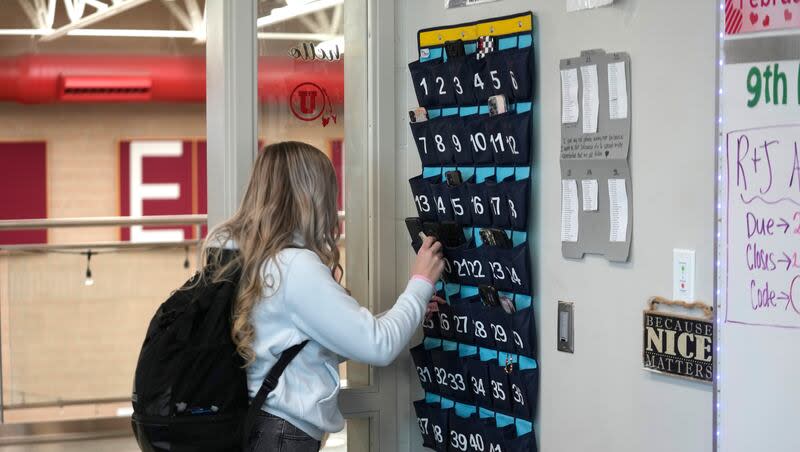A Utah Republican and a Connecticut Democrat want smartphones out of schools

- Oops!Something went wrong.Please try again later.
Sen. Mitt Romney wants to reduce the number of smartphones in classrooms.
Romney, R-Utah, and Sen. Chris Murphy, D-Conn., introduced the Smart Kids Not Smartphones Act on Thursday, that says any school that prohibits the use of smartphones during learning hours would receive some kind of recognition like a banner or website badge.
“There is no question that smartphones are a major distraction to students in the classroom,” said Romney in a press release. “They also contribute to deteriorating mental health, social isolation, and cyberbullying among our youth.”

The policy allows for exceptions for children with disabilities and times of emergencies or for the use of educational enrichment activities.
The act would also tell federal agencies to publish information schools can use for developing smartphone use policies as well as enforcement mechanisms.
School districts and state education would also be able to receive the non-monetary recognition award if 100% of the schools in their area develop a policy to prohibit smartphones.
“This simple bipartisan bill would recognize schools that implement smartphone bans during instructional time as well as provide transparency and give students and parents the opportunity to share input on those policies,” said Murphy.

There has been movement across different states to increasingly get smartphones out of schools.
What states have banned smartphones in schools?
Utah Gov. Spencer Cox has encouraged schools in the state to develop policies to help children focus on learning while in school.
While saying he does not believe in a one-size-fits-all approach, Cox said, “Placing cellphones in backpacks or lockers during class time allows students to give their undivided attention to lessons, to fully participate in discussions and to build relationships with their peers. Phone-free classrooms empower teachers to engage fully with their students.”
Cox pointed to Delta High School — students put their phones in a clear pocket when they enter the classroom. Assistant Principal Jared Christensen said, “It was a battle to begin with, but it has been so worth it. Students and parents have all adapted, our teachers are happier and learning has increased.”
Romney has praised Cox’s efforts on this issue, too.
“Nearly 97% of 11- to 17-year-olds with cellphones are using them during the school day for non-educational purposes, which can negatively affect students’ focus and academic performance. I commend @GovCox’s efforts to improve learning environments for Utah’s students,” said Romney on social media.
Earlier in July, Virginia Gov. Glenn Youngkin issued an executive order to restrict cellphone usage during school days.
“This essential action will promote a healthier and more focused educational environment where every child is free to learn,” said Youngkin in the release announcing the order.
The order says cellphone-free education is important for children’s mental health. Citing research from the American Psychological Association, the order said, “Children spend an average of 4.8 hours a day on social media, and recent studies indicate that spending more than three hours a day on social media doubles the risk of poor mental health for adolescents.”
New York Gov. Kathy Hochul has also called for banning smartphones in schools. The bill she launched would allow for students to carry phones without access to the internet, but that can send texts.
“I have seen these addictive algorithms pull in young people, literally capture them and make them prisoners in a space where they are cut off from human connection, social interaction and normal classroom activity,” Hochul told The Guardian.
Supporters of cellphone bans point toward research about how it positively impacts learning.
A 2022 study from psychology researchers Melissa Huey and David Giguere found when smartphones are removed from college students during class, they have higher levels of course comprehension and lower levels of anxiety.
What do teachers say about phones in school?
A survey conducted by Pew Research of K-12 teachers found 72% of high school teachers said cellphone distraction is a major problem. A majority of all K-12 teachers said it was difficult to enforce cellphone policies in their school or district.
Around 4 in 10 U.S. teens ages 13 to 17 told Pew Research they spend too much time on their smartphones. And a recent from Common Sense Media found that young people received an average of 237 notifications during the day. Around 60 notifications were received during the school day.
A Deseret News/Hinckley Institute Poll of 801 Utahns found 69% of respondents support banning smartphones during school hours. Respondents between the ages of 18 and 24 were the least supportive of the policy with half of them saying they do not support the policy.
Jonathan Haidt, a researcher at the forefront of this issue, has, like Jean Twenge, observed smartphones and social media have a damaging impact on youth mental health.
“Once young people began carrying the entire internet in their pockets, available to them day and night, it altered their daily experiences and developmental pathways across the board,” wrote Haidt in The Atlantic. “Friendship, dating, sexuality, exercise, sleep, academics, politics, family dynamics, identity — all were affected.”
Haidt said American schools should make themselves into phone-free zones. He also advocated for parents delaying giving phones to their children.
“If most parents would delay giving their child a smartphone until high school, providing only dumb phones until then, it would amplify the benefits of locking up phones in K-8 schools,” said Haidt. “It would mean that when a middle school lets out and kids are reunited with their phones, most of them would use those phones to call or text their friends and family, rather than devoting the next hour to scrolling through Instagram posts.”

